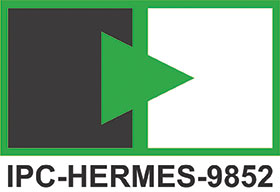

Hermes is the name of a recently created standard conceived to serve as a backbone for board-flow data management in smart electronics manufacturing facilities, by providing a vendor independent method of machine-to-machine communication for SMT (surface mount technology) assembly.
Taking advantage of modern TCP/IP communication and XML data format technologies, Hermes is effectively a replacement of the more than 20-year-old SMEMA (Surface Mount Equipment Manufacturers Association) standard (which carries the official designation IPC-SMEMA-9851), which is considered obsolete.
The Hermes standard was instigated by an independent group of equipment vendors and was officially launched at Productronica 2017 as an open standard under the auspices of the Hermes Standard Initiative. It has subsequently been recognised by IPC as the successor to SMEMA, and been assigned the official designation IPC-HERMES-9852. While it remains organisationally independent from the IPC body, close cooperation assure full compatibility, and both parties work together to guarantee a seamless fit, in particular with regards to the related IPC-CFX standard.
One standard to rule them all?
As with so many standardisation initiatives, there is no one standard to rule them all. Shortly after the Hermes standard was published, a group of mainly Japanese vendors, organised in a sub-committee of the Japanese Robot Association (JARA) decided not to join but to go for a similar yet separate approach that it calls JARAS 1014. While there has been some bickering between the two bodies, IPC’s support for Hermes positions it as the clear favourite to realise its goal of becoming the de facto global standard.
The Hermes Standard Initiative has been true to its claim of being truly open, and has a wealth of freely available information on its website, including the entire decision making process and all results, including the specification itself. It has also published an in-depth comparison between Hermes, JARAS 1014 and Fuji’s Easy Link solution.
All vendors of SMT equipment are free to join the Hermes Standard Initiative and to participate free of charge, and it counts roughly more than 50 companies amongst its membership, including most of the biggest names in the business from all across the globe.
Value proposition to manufacturers
Based on TCP/IP and XML, the Hermes standard uses modern communication technology and standardised data formats for machine-to-machine (M2M) communication. Its purpose is to transmit barcode information and board or job related data such as dimensions, board identifiers and product type identifiers together with the board along the machines of different vendors in an SMT line.
This means that a maximum of only one barcode scanner is required in the line. Besides this, the product itself becomes the driver of changes along the SMT line, so that manual adjustment of conveyor belt widths, for example, becomes unnecessary. Likewise, the information provided with a board can be used to automatically change the program according to the product type.
There are a number of clear benefits this offers to manufacturers of electronic assemblies. First of all, if all the machines on a production line are talking the same language, regardless of who made them, closed-loop handover is far more easily achievable.
Since it is protocol based rather than signal based, it is easier to adjust and expand for integrating further information. It also uses standard components in the form of Ethernet cables, plugs and interfaces that are inexpensive and readily available. If supported by the equipment, cables can even be done away with in favour of standard Wi-Fi.
New equipment can be used alongside existing SMEMA-only devices if required, but the full benefit will only unfold in lines where the majority of machines are compliant with IPC-HERMES-9852. According to the Hermes Standard Initiative, operational lines successfully making use of the standard have been running since June 2018, although no further details are provided.
For more information visit www.the-hermes-standard.info

© Technews Publishing (Pty) Ltd | All Rights Reserved